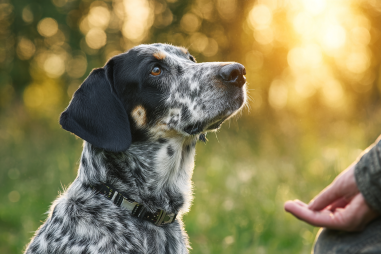The Bluetick Coonhound is a distinctive and energetic breed known for its tracking skills and friendly personality. However, like all dogs, this breed can exhibit behavior problems that, if left unaddressed, may lead to frustration for both owner and pet. Understanding these common behavior issues and their root causes is key to fostering a well-mannered, happy companion. In this article, we’ll dive into typical behavior problems seen in Bluetick Coonhounds and explore effective strategies to manage and prevent them.
Overview of Typical Behavior Problems
Bluetick Coonhounds are generally loving and loyal dogs, but certain behavior challenges can arise, particularly if their physical and mental needs aren’t adequately met. Some common issues include:
- Excessive Barking: Blueticks are known for their loud, distinctive baying, which can become problematic when it occurs excessively or at inappropriate times.
- Destructive Chewing: Especially if bored or anxious, Blueticks may chew on furniture or belongings.
- Separation Anxiety: These dogs thrive on companionship, so being left alone for long periods can lead to anxiety and related behaviors like pacing or vocalizing.
- Pulling on the Leash: Their hunting instincts make them eager to explore scents, often leading to strong leash pulling during walks.
- Escape Attempts: With their keen noses and determination, some Blueticks may try to dig or jump fences to follow scents.
Identifying these behaviors early can help owners implement measures to address them effectively.
Causes Related to Breed Characteristics
Many of the behavior problems encountered with Bluetick Coonhounds can be traced back to their breed makeup. Originally bred for hunting and tracking raccoons, these dogs possess a strong prey drive and high energy levels. Their natural instincts encourage exploration, scent tracking, and vocal communication. Understanding these intrinsic traits is essential for owners to set realistic expectations and tailor training approaches accordingly.
For example, a Bluetick’s vocal nature is part of its hunting heritage — barking and baying to alert their owners to prey. Without proper outlets for such behavior, they may bark excessively out of boredom or frustration. Similarly, their high energy needs mean they require ample exercise and mental stimulation; otherwise, pent-up energy can manifest as destructive activities or restlessness.
Training Strategies to Address Issues
Addressing behavior problems in Bluetick Coonhounds starts with consistent, positive training methods designed to harness their intelligence and enthusiasm. Here are some effective strategies:
- Early Socialization: Expose your Bluetick to various environments, people, and other animals while they are still young. This helps reduce fearfulness and promotes better temperament.
- Basic Obedience Training: Teaching commands such as sit, stay, come, and heel provides structure and helps control unwanted behaviors like leash pulling or ignoring recall.
- Use of Positive Reinforcement: Reward-based training with treats, praise, or toys encourages desired behaviors and strengthens your bond.
- Consistent Routine: Blueticks respond well to clear expectations and routines, which promote security and good manners.
- Leash Training: Practice loose-leash walking techniques and consider tools like front-clip harnesses to discourage pulling.
Patience and consistency are essential—avoid harsh corrections as these can damage trust and increase anxiety.
Behavioral Modification Techniques
When typical training isn’t enough to curb problem behaviors, behavioral modification techniques can be beneficial. These approaches work by changing the dog’s emotional response to triggers or situations:
- Desensitization and Counter-Conditioning: Gradually exposing your dog to stimuli that provoke problem behavior, while pairing exposure with positive experiences, can help reduce negative reactions such as excessive barking or anxiety.
- Redirecting Energy: For destructive chewing or hyperactivity, providing appropriate outlets like chew toys, puzzle feeders, or engaging activities can satisfy their instincts productively.
- Crate Training: A well-introduced crate offers a safe retreat and can decrease anxiety-related behaviors.
- Impulse Control Exercises: Training games that teach patience and delayed gratification (like “leave it” or “wait”) help Blueticks develop self-control.
These techniques may require time and commitment but often produce long-lasting improvements.
When to Seek Professional Help
Some behavior problems may be challenging to resolve on your own, especially if they involve aggression, severe anxiety, or compulsive actions. In such cases, consulting a professional dog trainer or a veterinary behaviorist can be invaluable. These experts can:
- Assess the underlying causes of behavior problems.
- Create tailored modification plans suited to your Bluetick’s temperament.
- Provide guidance on medication or therapy if necessary.
- Support you through challenging behavior management processes.
Early intervention often leads to better outcomes, so do not hesitate to seek help if you feel overwhelmed or if your dog’s behavior poses safety risks.
Preventative Measures to Keep Your Bluetick Well-Behaved
Prevention is always better than cure when it comes to behavior issues. Owners can take several steps to reduce the likelihood of problems developing:
- Ensure Adequate Exercise: Bluetick Coonhounds need daily, vigorous exercise to expend their energy and stay mentally sharp.
- Mental Enrichment: Use interactive toys, scent games, or training sessions to keep their minds engaged.
- Provide Socialization Opportunities: Regularly introduce your dog to new experiences to build confidence and friendliness.
- Maintain Consistent Training: Reinforce good habits regularly and be clear about house rules to provide structure.
- Address Issues Early: Even minor behavior quirks should be corrected before they become entrenched problems.
By proactively meeting a Bluetick’s physical, mental, and emotional needs, owners can minimize the risk of behavior problems and enjoy a harmonious relationship.
Helping Your Bluetick Thrive
The Bluetick Coonhound is a wonderful companion with a unique blend of friendliness, intelligence, and spirited energy. However, their strong hunting instincts and need for stimulation can lead to behavior challenges if not managed carefully. By understanding their natural tendencies, applying consistent training methods, and committing to their physical and mental well-being, owners can address behavior problems effectively. Remember, patience and positive reinforcement go a long way in nurturing a happy, well-behaved Bluetick. If difficulties persist, seeking professional advice ensures your beloved pet gets the support they need to thrive.






